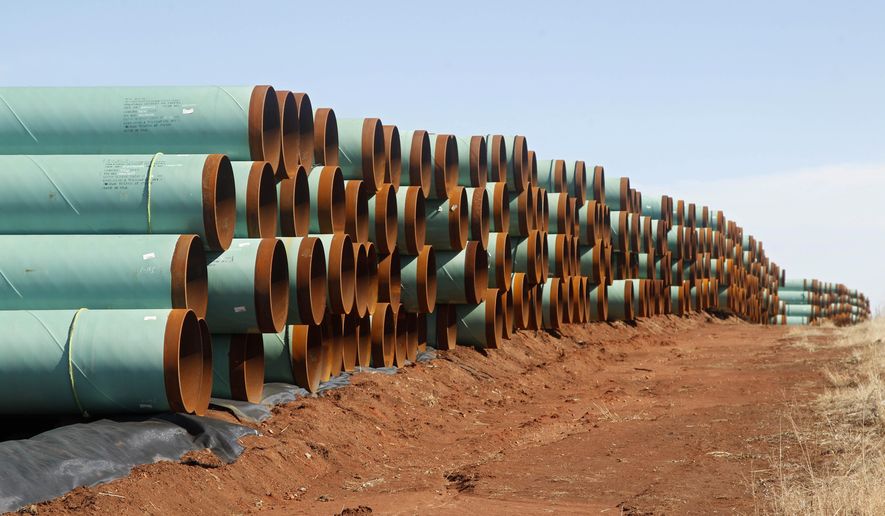President Trump recently declared that pipelines are “environmentally better” than other methods of moving oil and gas, reigniting an ongoing debate about the safest way to move the nation’s abundant energy supply — but data show the truth is somewhat murky and depends largely on one’s perspective.
Mr. Trump’s statement came at a North Dakota rally to promote his tax reform plan, and the president also used the event to tout his approval of the Keystone XL and Dakota Access pipelines, both of which have become major flashpoints in the energy versus environment debate.
Pipeline champions, including those in the administration, argue that moving American fuel by pipeline is not only safer but also more economical, better for the environment and much more efficient.
“Nobody can quite match the pipeline safety record,” said Brigham McCown, the former head of the federal Pipeline and Hazardous Materials Safety Administration who also served as an adviser in Mr. Trump’s Transportation Department.
Pipeline opponents, he argues, simply want to stop fossil fuel development.
“They try to cloak their climate change agenda under themes of safety regarding pipelines, and it’s frankly intellectually disingenuous,” Mr. McCown said.
But many environmentalists say that to the extent the U.S. is going to continue drilling and burning oil, they want to see it moved by rail, not pipeline.
“Obviously the best means of transportation of oil is none but I would rather see any kind of new spike in oil, like we saw in the Bakken [Shale], I would rather see that go by train,” said Jane Kleeb, president of the Bold Alliance, a group that’s led the charge against the Keystone XL pipeline.
Ms. Kleeb also contends that rail transport means the U.S. will use most of the fuel domestically, whereas oil moved by pipeline sometimes heads to refineries along the coast and ultimately is sent overseas.
Beneath the political arguments and high-profile incidents of both pipeline spills and train derailments — such as the 2013 crude oil train derailment in Quebec that killed more than 40 people or a 2016 pipeline spill in North Dakota that reportedly released more than 175,000 gallons of fuel — are facts and figures that tell a complicated story. Data show that rail accidents are more common than pipeline spills, but pipeline spills, in many cases, will result in the release of much more fuel.
An International Energy Agency report that examined U.S. data from 2004 to 2012 found that the risk of a rail accident is six times higher than that of a pipeline. At the same time, a pipeline will spill three times as much oil per 1 billion barrel miles of fuel transported.
Even then, however, it’s difficult to make an apples-to-apples comparison. The IEA study, which pulled data from a variety of sources, said there’s also conflicting definitions in what constitutes a spill.
“Any spill constitutes a railway incident in these calculations, while only spills over 5 gallons constitutes a pipeline spill,” the report states, underscoring different reporting standards that make comparisons difficult.
While the sheer volume of crude oil released in pipeline spills may seem staggering — about 9 million gallons since 2010, according to data assembled by the digital magazine Undark — there are other costs to consider.
Perhaps most notably, pipelines carry less of a human risk, as rail and trucks put more vehicles and human beings on the road.
“From a safety standpoint, just think about the issue: Is it safer to transport natural gas or oil through a pipeline, or is it safer to put tens of thousands of rail cars on the rails every day or literally millions of trucks every year to transport that same amount of material?” said Ret. Army Col. Marc R. Hildenbrand, who now serves as a senior adviser at Dawson & Associates and specializes in fuel transportation.
Indeed, rail is by no means a completely safe alternative, especially given the increased use of trains as U.S. energy development has skyrocketed. In 2014 the nation set a new record for “unintentional releases” of fuel from rail cars at 141. Until 2012 the nation had averaged about two dozen spills per year, according to federal figures.
What’s more difficult to calculate is the amount of greenhouse gas emissions eliminated by the use of pipelines versus the use of rail. Specialists point out that rail and trucks require more time and fuel to operate, adding another dynamic to consider.
Pipelines “are the only one-way transportation system we have,” Mr. McCown said. “Everything else requires a round trip.”
Both sides of the debate seem easily able to cherry-pick certain data to make their points, but the president makes no bones about which side of the fence he’s on.
“The Dakota Access Pipeline is finally open for business I also did Keystone,” Mr. Trump said last week in his North Dakota speech. “Tremendous thing. I think environmentally better. I really believe that — environmentally better.”
• Ben Wolfgang can be reached at bwolfgang@washingtontimes.com.




Please read our comment policy before commenting.